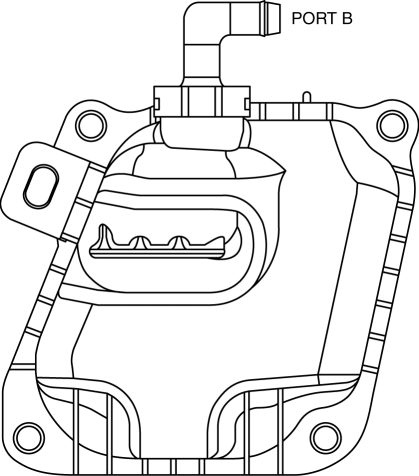Mazda CX-5 Service & Repair Manual: Positive Crankcase Ventilation (PCV) Valve Inspection
Airflow Inspection
1. Disconnect the section (A) of ventilation hose shown in the figure.

2. Start the engine and verify that vacuum is applied to the end of the disconnected ventilation hose while the engine is idling.
-
If vacuum is not applied to the ventilation hose, perform the procedure from Step 3.
NOTE:
-
If the PCV valve is operating normally, vacuum occurs in the ventilation hose, however, if the PCV valve is not operating normally, vacuum does not occur in the ventilation hose because the blow-by gas is circulated to the air hose from the ventilation hose.
-
Verify the ventilation hose vacuum as follows:
-
When the tip of your figure is touching the end of the ventilation hose, the tip of your figure is suctioned by the hose.
-
When a thin scrap of paper is contacting the end of the ventilation hose. the paper is suctioned by the hose.
3. Disconnect the negative battery cable..
4. Remove the intake manifold..
5. Remove the PCV valve and the oil separator as a single unit..
6. Verify that there is no airflow when pressure is applied to port B.

-
If there is airflow, replace the PCV valve and the oil separator as a single unit..
7. Verify that there is airflow when vacuum is applied to port B.
-
If there is no airflow, replace the PCV valve and the oil separator as a single unit..
 Positive Crankcase Ventilation (PCV) System
Positive Crankcase Ventilation (PCV) System
Purpose, Outline
Prevents release of blow-by gas (unburnt gas) into the atmosphere.
The intake manifold vacuum introduces blow-by gas to the intake manifold
via the PCV valve and the ...
 Positive Crankcase Ventilation (PCV) Valve Removal/Installation
Positive Crankcase Ventilation (PCV) Valve Removal/Installation
1. Disconnect the negative battery cable..
2. Remove the intake manifold..
3. Remove in the order indicated in the table.
4. Install in the reverse order of removal.
1
...
Other materials:
Magnet Clutch [Manual Air Conditioner]
Purpose
The magnetic clutch transmits the rotation force from the engine to the shaft
in the A/C compressor.
Function
The magnetic clutch engages or disengages the magnetic clutch and the A/C
turns on or off by switching the power transmission from the engine.
Con ...
On Board Diagnostic System Simulation Inspection [Fw6 A EL, Fw6 Ax EL]
1. Connect the M-MDS to the DLC-2.
2. After the vehicle is identified, select the following items from the initialization
screen of the M-MDS.
a. Select “DataLogger”.
b. Select “Modules”.
c. Select “TCM”.
3. Select the simulation items from the PID table.
4. Perform the act ...
Air Bag Module And Pre Tensioner Seat Belt Deployment Procedures [Two Step Deployment
Control System]
WARNING:
A live (undeployed) air bag module, pre-tensioner seat belt or lap pre-tensioner
seat belt may accidentally operate (deploy) when it is disposed of and cause
serious injury. Do not dispose of a live (undeployed) air bag module, pre-tensioner
seat belt or lap pre-tensioner s ...
